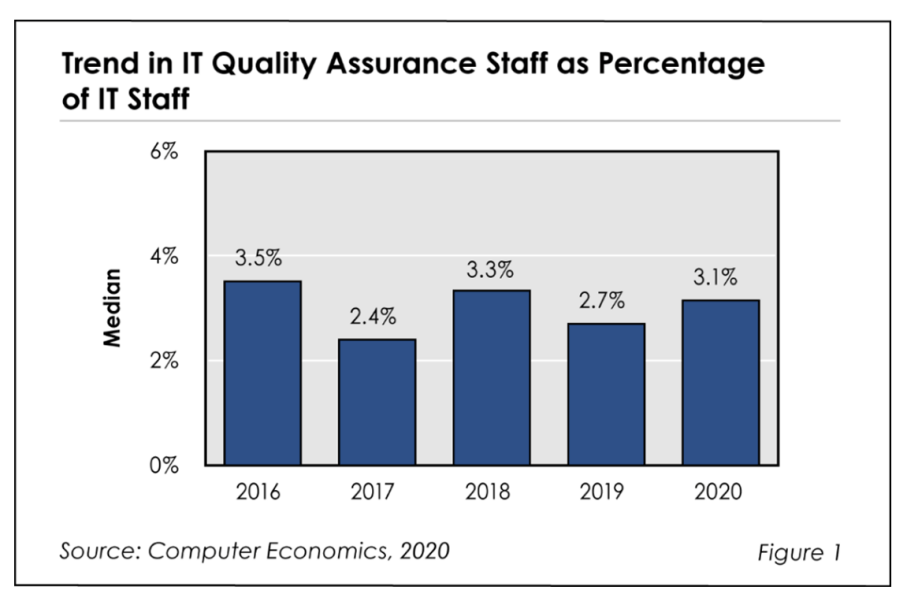IT quality assurance has always been a small but vital role in IT organizations. However, the role of quality assurance as a discrete job position is in a state of flux.
The changing nature of software development is a big influence in this staffing ratio. Most companies have abandoned, at least in part, the traditional waterfall software development model in favor of agile development methodologies, such as scrum, and other iterative approaches. Waterfall development models usually incorporate distinct testing phases where QA and testing personnel are dedicated to detecting flaws in program code.
As seen in Figure 1 from our full report, IT Quality Assurance Staffing Ratios, the result is that the percentage of QA staff as a percentage of the total IT staff has been on a bit of a roller coaster, dropping to 2.4% 2017 and then rising to 3.1% in 2020. Part of the volatility is because QA personnel make up such a small percentage of the total IT staff that small changes are more obvious.

Newer development models rely on quicker iterations of development with testing, often supported by automated test tools. The natural extension of this approach is DevOps, where developers apply enhancements as small, incremental changes that are tested and committed daily, hourly, or even moment by moment into the production system. The result is faster development cycles, with less rework, and higher quality.
“The QA role is becoming more strategic,” said Tom Dunlap, director of research for Avasant, a global management consulting firm based in Los Angeles. “The changing face of QA is elevating the job position but spreading the role through the organization. The job now is more about implementing and maintaining the tools that automate much of the routine testing activities.”
Even without a full DevOps approach, it is becoming increasingly difficult to identify how much of the IT staff is dedicated to QA. If developers spend the bulk of their time writing code, a part on regression-testing their own code, and a part on reviewing or testing code of other developers, they likely would not be identified as QA staff.
With low-level testing activities largely subsumed into the jobs of application development staff, the IT quality assurance personnel that remain will focus mostly on QA policies and procedures, implementing and maintaining automated testing tools, and ensuring compliance. For shops that have transitioned to a DevOps environment, these remaining QA activities would probably be subsumed into the role of the DevOps engineer.
The full report provides benchmarks for assessing current quality assurance staffing levels. In our overview, we present the five-year trend in quality assurance staffing. We then provide three benchmarks by organization size and sector: QA staff as a percentage of the IT staff, QA staff as a percentage of the Application Group, and applications per QA staff member. We conclude with recommendations for improving the effectiveness of the quality assurance function within the IT organization.
This Research Byte is a brief overview of our report on this subject, IT Quality Assurance Staffing Ratios. The full report is available at no charge for Avasant Research subscribers, or it may be purchased by non-subscribers directly from our website (click for pricing).

